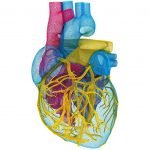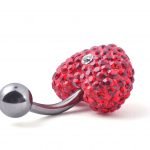Beyond Hawthorn: Herbs for Cardiovascular Health
Robin DiPasquale, ND, RH (AHG)
In the realm of herbal treatment for cardiovascular disease, certainly Crataegus oxyacantha, and other species of hawthorn, is the first plant medicine that comes to mind. Because it is a cardiac tonic, most patients with cardiovascular issues should consider taking some form of hawthorn, whether it is an infusion of the leaf and flower, a decoction of the berries, an alcohol or glycerine extract, a solid extract, a gemmotherapy extract, a flower essence, or an encapsulated plant. Crataegus dilates coronary arteries, increasing oxygenation to the heart muscle and reducing risk and relieving symptoms of angina. It is a positive inotrope, enhancing the contractility of the cardiac muscle and slowing down senile degeneration as seen in cardiovascular degenerative disease, and is used for coronary artery disease, mild congestive heart failure, and hypertension. Hawthorn is also the herb to consider when there are emotional issues of the heart that lead to pathology of the heart. Crataegus does not contain cardiac glycosides, has no toxic effects, and can be used long term. An increase in cyclic adenosine monophosphate inhibits degranulation of mast cells, leading to bronchodilation, which is the mechanism by which Crataegus is an effective herb for the treatment of asthma as well. Beyond hawthorn, other herbal remedies bring significant relief from symptoms and healing action for cardiac conditions.
Cardiotonic and Cardioprotective Herbs
Terminalia arjuna is the counterpart to hawthorn in Ayurvedic medicine. The bark is used medicinally from this Combretaceae family tree, a relative to Haritaki and Bibhitaki, both found in Triphala. Arjuna is considered a cardiotonic and cardioprotective agent, stimulates circulation, acts as an alterative, and is high in antioxidants. It is inflammation modulating, decreases phlegm accumulation, and assists in bringing the nutrient supply to the heart, enhancing the effectiveness of each heartbeat.1,2 Arjuna is used in India to treat all forms of heart disease, including mild congestive heart failure, endocarditis, pericarditis, arrhythmias, tachycardia, edema, and hypertension. It reduces the episodes and pain of angina, and with its ability to decrease total cholesterol and triglycerides levels and to increase high-density lipoprotein cholesterol levels, Arjuna is used to treat coronary artery disease and ischemic heart disease.3,4 In Ayurvedic medicine, Arjuna bark is boiled in milk and often combined with black pepper or ginger for warming effects and to enhance absorption.5
In southern Appalachian herbal medicine, it is said that “thick” blood or “sticky” blood is behind most chronic disorders, especially cardiovascular diseases. Without the blood moving freely, stagnation occurs, and inflammation is increased; with this combination of stagnation and inflammation can come pathology and dysfunction. Herbal medicine has many plants that act to thin the blood, decreasing viscosity and allowing blood to flow more effectively through the body. Ginkgo biloba (ginkgo) and Allium sativum (garlic) have been extensively studied. In ginkgo, the ginkgolides are thought to inhibit platelet–activating factor, and it is postulated that the allicin and alliin in garlic inhibit platelet–activating factor and stimulate fibrinolysis.6 The gemmo remedy Citrus limonum (lemon tree) moves blood and increases circulation, quelling stagnation. Cornus sanguinea (dogwood) in the gemmo preparation has anticoagulant and antithrombotic actions.7
According to Felter, the specific indications for Convallaria majalis (lily of the valley) are as follows: “Cardiac irregularities due to mechanical impediments; mitral valve insufficiency; feeble circulation and low arterial tension; dropsy of cardiac origin; palpitations and vehement heart action, with arrhythmic movements, dyspnea, and diminished arterial pressure; feeble, quickened pulse, with capillary obstruction.”8(p321)
Convallaria contains cardiac glycosides, similar to Digitalis purpurea, In lily of the valley, however, they are not cumulative, allowing this herb to act more gently than its counterpart. Convallaria is indicated in cases of heart irregularities due to obstruction more than degenerative, imperfect circulation within the heart secondary to feeble peripheral flow. In small and continued doses, Convallaria increases the force of the heartbeat by strengthening the heart muscle, slows the pulse by tonifying the vessels, and enhances renal action, leading to increased diuresis. In moderate doses, it can correct heart arrhythmias. Lily of the valley is an herb to be considered an ongoing tonic in cases of mitral valve prolapse.
To Calm the Nervous System
Two herbs that have species names related to their support in cardiovascular health are Tilia cordata (linden or lime blossom) and Leonurus cardiaca (motherwort). Both work by influencing the nervous system. The heart-shaped leaves of the linden tree portray its doctrine of signature. Tilia is a nervine, relaxing anxiousness and nervous tension. It is an antispasmodic and a vasodilator and acts as a diaphoretic and diuretic, all actions contributing to more effective cardiovascular function. As a cardiotonic and circulatory tonic, it can treat arteriosclerosis and hypertension. Tilia harmonizes the heart and the mind, calming the shen. Linden can be taken long term, consumed as an infusion or a tincture of the flowers or in the gemmotherapy preparation from the bud. Leonurus has nervine, cardiotonic, antispasmodic, and hypotensive actions. As described by Weiss, the indications are “mainly for functional heart complaints due to autonomic imbalance.”9(p) Motherwort is quite bitter, most likely working through the gastrointestinal tract. Although infusion will extract the iridoids, diterpenes, and other constituents, its bitter taste makes it more easily dosed through tincture.
Selenicereus grandiflorus (night-blooming cereus) is another herb to keep in your repertory when heart arrhythmias are a reported symptom, especially those related to anxiety and the nervous system. Felter says: “Cactus impresses the sympathetic nervous system, and is specially active in its power over the cardiac plexus…cactus is a remedy chiefly for functional disorders of the heart due to nervous origin…and one of the best of cardiac tonics.”8(p254) Cactus can be used in cases of aortic regurgitation and mitral valve prolapse but is contraindicated in patients with stenotic valves. It is especially useful for mild congestive heart failure and heart palpitations related to anxiety or to menopause.
Herbs that are more specifically within the nervine category can be useful in times of heart arrhythmias when anxiety is a driving factor. Scutellaria lateriflora (skullcap) and Avena sativa (milky oats) can be combined as trophorestoratives for the nervous system. Scutellaria and Passiflora incarnata (passionflower) combine well to work more as a sedative. Piper methysticum (kava) is an anxiolytic agent without drowsiness, reduced alertness, or decreased function when given at therapeutic doses.
To Stop Platelet Agglutination
Salvia miltiorrhiza (danshen) provides cardioprotection and vasodilation and acts to keep platelets from agglutinating. In Traditional Chinese Medicine, danshen enters the heart, pericardium, and liver channels. It invigorates the blood and breaks up congealed blood, clears heat, and soothes irritability.10 Moving blood through the heart and circulatory system, as well as the liver, allows for better cardiovascular function all around. Salvia miltiorrhiza acts as an anticoagulant and a fibrinolytic. It is vasodilatory, specifically on coronary arteries. It causes mild peripheral vasodilation, which along with the sedative effects on the central nervous system can decrease blood pressure. Danshen can be used to treat angina and to counteract myocardial ischemia. It may contribute to a decrease in cholesterol levels. Salvia miltiorrhiza is not a cardiotonic but can potentiate the effects of cardiotonic herbs when used in formula for enhancing cardiovascular function.2
Antispasmodic Herbs
In the gemmotherapy preparation, Syringa vulgaris (lilac) is antispasmodic, allowing vasodilation, especially of the coronary arteries. It is indicated specifically for tightness in the chest, angina, and arteriosclerosis and is used in very small doses, beginning at 1 to 2 drops, especially for senile hearts.7
Coleus forskohlii has positive inotropic action, increasing cardiac contractility. The forskolin in Coleus increases cyclic adenosine monophosphate (activating adenylate cyclase, which reduces platelet-activating factor), inhibits basophil and mast cell degranulation, and decreases histamine release (facilitating vasodilation throughout the cardiovascular system). In patients with hypertension, this vasodilation allows for a decrease in systolic and diastolic blood pressures.11 Coleus can be useful in patients with congestive heart failure and in some cases of angina.
Herbs for Topical Application
Topical application can influence cardiovascular wellness. Kneipp heart ointment consists of Rosmarinus essential oil, camphor, and menthol and is applied topically as an aid in symptomatic treatment of heart complaints. Rosmarinus, with its high rosmarinic acid content, is invigorating, energizing, and gets things moving, and it is a strong antioxidant herb. A topical cream made anthroposophically with gold, the precious metal of the heart chakra, can be rubbed over the heart to address physical and emotional imbalances.
Enhance Glomerular Filtration and Venous Flow
Herbal diuretics can enhance elimination of fluids through the kidneys. Although many herbs have diuretic action, one of the top considerations is Taraxacum officinale (dandelion leaf), a potassium-sparing herbal diuretic that acts effectively to enhance glomerular filtration. In cases of cardiovascular compromise with kidney damage and decreased glomerular function, combining Taraxacum leaf with the Urticaceae family plant Parietaria diffusa (pellitory of the wall), also called the Silybum of the kidneys, can support repair and return to function. The gemmo remedies of Juniperus communis and Zea mays are also very effective diuretics. Some concern has been noted about the potential irritation of the urinary tract mucosa with juniper. The gemmo remedy is prepared from the new shoots of the plant, with the potential for irritation greatly diminished.
If the problem is varicose veins, with lack of venous tone often being the case, consider Aesculus hippocastanum (horse chestnut) and Ruscus aculeatus (butcher’s broom). The gemmo of Sorbus domestica (service tree) will enhance venous flow and tonify the venous endothelium lining via its antioxidant action. The gemmo preparations of S domestica and Castanea vesca (sweet chestnut) work hand in hand to enhance venous and lymphatic flow throughout the body.
When working with patients having cardiovascular disease, consider C oxyacantha as a foundational herb. Moving on from there, expand your materia medica to fine-tune your therapies and enhance their effectiveness, going beyond hawthorn.
 Robin DiPasquale, ND, RH (AHG) earned her degree in naturopathic medicine from Bastyr University in 1995 where, following graduation she became a member of the didactic and clinical faculty. For the past eight years she has served at Bastyr as department chair of botanical medicine, teaching and administering to both the naturopathic program and the bachelor of science in herbal sciences program. Dr. DiPasquale is a clinical associate professor in the department of biobehavioral nursing and health systems at the University of Washington in the CAM certificate program. She loves plants, is published nationally and internationally, and teaches throughout the U.S. and in Italy on plant medicine. She is an anusara-influenced yoga instructor, teaching the flow of yoga from the heart. She currently has a general naturopathic medical practice in Madison, Wis., and is working with the University of Wisconsin Integrative Medicine Clinic as an ND consultant.
Robin DiPasquale, ND, RH (AHG) earned her degree in naturopathic medicine from Bastyr University in 1995 where, following graduation she became a member of the didactic and clinical faculty. For the past eight years she has served at Bastyr as department chair of botanical medicine, teaching and administering to both the naturopathic program and the bachelor of science in herbal sciences program. Dr. DiPasquale is a clinical associate professor in the department of biobehavioral nursing and health systems at the University of Washington in the CAM certificate program. She loves plants, is published nationally and internationally, and teaches throughout the U.S. and in Italy on plant medicine. She is an anusara-influenced yoga instructor, teaching the flow of yoga from the heart. She currently has a general naturopathic medical practice in Madison, Wis., and is working with the University of Wisconsin Integrative Medicine Clinic as an ND consultant.
References
- Dwivedi S, Chansouria JPN, Somani PN, Udupa KN. Influence of certain indigenous drugs on the PGE-like activity in the ischemic rabbit aorta. Indian Drugs. 1987;24:378.
- Bone K. Clinical Applications of Ayurvedic and Chinese Herbs. Queensland, Australia: Phytotherapy Press; 1996.
- Tiwari AK, Gode JD, Dubey GP. Effect of Terminalia arjuna on lipid profiles of rabbits fed hypercholesterolemic diet. Int J Crude Drug Res. 1990;28:43-47.
- Vaidya AB. Terminalia arjuna in cardiovascular therapy. J Assoc Physicians India. 1994;42(4):281-282.
- Khalsa KP, Tierra M. The Way of Ayurvedic Herbs. Twin Lakes, WI: Lotus Press; 2008.
- Blumenthal M. The ABC Clinical Guide to Herbs. Austin, TX: American Botanical Council; 2003.
- DiPasquale R. Introductory Training Manual. Brooklyn, NY: Gemmos LLC; 2011.
- Felter HW. The Eclectic Materia Medica, Pharmacology and Therapeutics. Vol 1. Sandy, OR: Eclectic Medical Publications; 1983:321. Naturopathic Medical Series. First published in Cincinnati, OH, in 1922.
- Weiss RF. Herbal Medicine. Beaconsfield, England: Beaconsfield Publishers Ltd; 1988.
- Bensky D, Gamble A. Chinese Herbal Medicine: Materia Medica. Seattle, WA: Eastland Press; 1986.
- Dubey MP, Srimal RC, Nityanand S, Dhawan BN. Pharmacological studies on coleonol, a hypotensive diterpene from Coleus forskohlii. J Ethnopharmacol. 1982;3:1-13.










